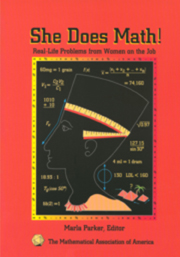Book contents
- Frontmatter
- Preface
- Contents
- Problems by Subject
- Environmental Psychology
- Software Engineering; Computer Science
- Archaeology
- Mathematics and Computer Science
- Civil Engineering
- Mathematics
- Electrical Engineering
- Physics; X-ray Astronomy Research
- Mathematics
- Physics; Astronaut Crew Training Instructor
- Business Data Processing
- Software Engineering; Real Estate Investment
- Quality Engineering
- Health Science
- Nursing Education
- Electrical Engineering; Space Systems
- Oil and Gas Accounting
- Business Administration Higher Education
- Aerospace Engineering
- Structural Engineering
- Computer Science
- Mathematics
- Dietetics—Foodservice Management and Nutrition
- Electrical Engineering
- Chemical Engineering, retired
- Software Engineering
- Immunology and Microbiology
- Mechanical Engineering
- HMO Pharmacy Practice and Management
- Ophthalmology
- Electrical Engineering
- Fish Pathology
- Computer Science and Computer Graphics
- Mathematics and Computing
- Electrical Engineering
- Astronomy
- Author
- Mathematics
- Reflections on WAM
- Solutions
Electrical Engineering
- Frontmatter
- Preface
- Contents
- Problems by Subject
- Environmental Psychology
- Software Engineering; Computer Science
- Archaeology
- Mathematics and Computer Science
- Civil Engineering
- Mathematics
- Electrical Engineering
- Physics; X-ray Astronomy Research
- Mathematics
- Physics; Astronaut Crew Training Instructor
- Business Data Processing
- Software Engineering; Real Estate Investment
- Quality Engineering
- Health Science
- Nursing Education
- Electrical Engineering; Space Systems
- Oil and Gas Accounting
- Business Administration Higher Education
- Aerospace Engineering
- Structural Engineering
- Computer Science
- Mathematics
- Dietetics—Foodservice Management and Nutrition
- Electrical Engineering
- Chemical Engineering, retired
- Software Engineering
- Immunology and Microbiology
- Mechanical Engineering
- HMO Pharmacy Practice and Management
- Ophthalmology
- Electrical Engineering
- Fish Pathology
- Computer Science and Computer Graphics
- Mathematics and Computing
- Electrical Engineering
- Astronomy
- Author
- Mathematics
- Reflections on WAM
- Solutions
Summary
I was born in Bangladesh, and went to all-girls schools where it never occured to anyone that girls were not supposed to be good at mathematics and science. In ninth grade, we had to choose a “track”—either science or humanities. Once you chose a track, you couldn't switch back to the other track, because you would have missed too many courses and there was no way of making them up.
The science track included advanced mathematics, physics, inorganic and organic chemistry, biology, calculus, statics, and dynamics. Both tracks taught algebra and geometry, but the science students took more of both. In eleventh and twelfth grades, science students chose between advanced geography and biology. To go to medical school, you had to take biology. However, by that time I had decided to be an electrical engineer, so I chose geography.
Although my childhood dream was to become a writer or painter, or both, I thought that the safest bet was to become an engineer. At that time, the job market in Bangladesh guaranteed that an engineering degree would lead to a decent job (alas, it is not so any more.) Besides, I thought that as an engineer, I could still write or paint in my spare time, but just try to be a full-time writer and do engineering on the side!
Of course, at that time almost no women went into engineering, particularly electrical.
- Type
- Chapter
- Information
- She Does Math!Real-Life Problems from Women on the Job, pp. 102 - 105Publisher: Mathematical Association of AmericaPrint publication year: 1995

